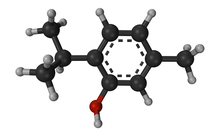
| |

| |
| Names | |
|---|---|
| Preferred IUPAC name
5-Methyl-2-(propan-2-yl)phenol[1] | |
| Systematic IUPAC name
5-Methyl-2-(propan-2-yl)benzenol | |
| Other names
2-Isopropyl-5-methylphenol, isopropyl-m-cresol, 1-methyl-3-hydroxy-4-isopropylbenzene, 3-methyl-6-isopropylphenol, 5-methyl-2-(1-methylethyl)phenol, 5-methyl-2-isopropyl-1-phenol, 5-methyl-2-isopropylphenol, 6-isopropyl-3-methylphenol, 6-isopropyl-m-cresol, Apiguard, NSC 11215, NSC 47821, NSC 49142, thyme camphor, m-thymol, and p-cymen-3-ol
| |
| Identifiers | |
3D model (JSmol)
|
|
| ChEBI | |
| ChEMBL | |
| ChemSpider | |
| DrugBank | |
| ECHA InfoCard | 100.001.768 |
| EC Number |
|
| KEGG | |
PubChem CID
|
|
| UNII | |
CompTox Dashboard (EPA)
|
|
| |
| |
| Properties | |
| C10H14O | |
| Molar mass | 150.221 g·mol−1 |
| Density | 0.96 g/cm3 |
| Melting point | 49 to 51 °C (120 to 124 °F; 322 to 324 K) |
| Boiling point | 232 °C (450 °F; 505 K) |
| 0.9 g/L (20 °C)[2] | |
Refractive index (nD)
|
1.5208[3] |
| Pharmacology | |
| QP53AX22 (WHO) | |
| Hazards | |
| GHS labelling: | |
  
| |
| Warning | |
| H302, H314, H411 | |
| P260, P264, P270, P273, P280, P301+P312, P301+P330+P331, P303+P361+P353, P304+P340, P305+P351+P338, P310, P321, P330, P363, P391, P405, P501 | |
Except where otherwise noted, data are given for materials in their standard state (at 25 °C [77 °F], 100 kPa).
| |
Thymol (also known as 2-isopropyl-5-methylphenol, IPMP), C10H14O, is a natural monoterpenoid phenol derivative of p-Cymene, isomeric with carvacrol, found in oil of thyme, and extracted from Thymus vulgaris (common thyme), ajwain,[4] and various other plants as a white crystalline substance of a pleasant aromatic odor and strong antiseptic properties. Thymol also provides the distinctive, strong flavor of the culinary herb thyme, also produced from T. vulgaris. Thymol is only slightly soluble in water at neutral pH, but it is extremely soluble in alcohols and other organic solvents. It is also soluble in strongly alkaline aqueous solutions due to deprotonation of the phenol. Its dissociation constant (pKa) is 10.59±0.10.[5] Thymol absorbs maximum UV radiation at 274 nm.[6]
- ^ "Front Matter". Nomenclature of Organic Chemistry : IUPAC Recommendations and Preferred Names 2013 (Blue Book). Cambridge: The Royal Society of Chemistry. 2014. p. 691. doi:10.1039/9781849733069-FP001. ISBN 978-0-85404-182-4.
- ^ "Thymol". PubChem. Retrieved 1 April 2016.
- ^ Mndzhoyan, A. L. (1940). "Thymol from Thymus kotschyanus". Sbornik Trudov Armyanskogo Filial. Akad. Nauk. 1940: 25–28.
- ^ O'Connell, John (27 August 2019). The book of spice : from anise to zedoary. New York: Pegasus. ISBN 978-1681774459. OCLC 959875923.
- ^ CAS Registry: Data obtained from SciFinder[full citation needed]
- ^ Norwitz, G.; Nataro, N.; Keliher, P. N. (1986). "Study of the Steam Distillation of Phenolic Compounds Using Ultraviolent Spectrometry". Anal. Chem. 58 (639–640): 641. doi:10.1021/ac00294a034.